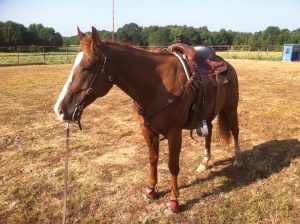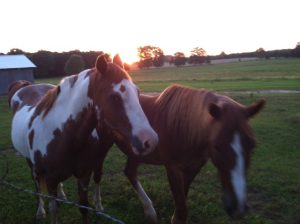
Knockout sporting his new headstall
Sunday morning dawned a cool, clear, beautiful Spring day! 🙂
I rose early to sip a cup of coffee before slipping quietly out of the house to saddle Knockout for a quick ride before church.
I carried a pair of shears for trimming brush along the path. The first time trimming brush with Knockout went so well, I decided to trim another short trail loop.
After a relaxed trot to the back pasture, we entered the woods and I pulled out my shears as we approached the first overgrown bush. Knockout showed considerable concern. He was clearly uncomfortable with both the shears in my hand and the close proximity to the bush!
Honestly, I was a bit surprised. A few weeks ago when I first introduced Knockout to trimming brush, he was much calmer than I had anticipated. So, I was expecting to pick right up this time. But that’s not where Knockout’s head was that morning.
So, I followed Ray Hunt’s advice to “work with the horse you have today.” We took a few minutes to incrementally rebuild Knockout’s confidence with both the shears and close proximity to thick brush, and within five minutes Knockout was nice and relaxed as I snipped away with leaves and small branches falling on his head and around his shoulders.
About halfway through the trail, I moved Knockout toward an overgrown pin oak branch. Knockout acted tense about this particular branch and kept trying to move away from it. This surprised me, since he had been so relaxed up to that point.
Thinking Knockout might be bothered by the shear number of little branches and leaves on a pin oak, I decided to start snipping at the edge and gradually work our way closer. That worked pretty well, but then we reached a point Knockout started acting nervous again. I thought maybe the small pine log lying in the trail was a concern, but studying it carefully I didn’t see any sign of snakes or other danger…and decided if the log was causing him angst, then he needed to learn to relax near the log.
So, once again we spent a couple of minutes rebuilding confidence, until Knockout was standing relaxed with his front hooves straddling the log. He stood for several minutes in that position as I snipped all the branches I could reach, then I asked him to step closer to the tree.
AND…he backed completely out of reach! …and acted hesitant about coming any closer…
That’s really not like him. So, once again I scanned the area to try to figure out what he was concerned about.
That’s when I saw it. That pine log he had been straddling was completely covered in fire ants! The ants were hidden beneath the log, but swarmed Knockout’s front legs when his weight disturbed their home.
I felt so bad! Poor Knockout! 🙁
I quickly dismounted and brushed the ants off his legs as best I could. Then I remounted and we found another way to access the pin oak branch without stepping near the fire ants’ log. Knockout was good as gold the rest of the ride, and we finished trimming that particular trail loop.
Riding home, I couldn’t stop thinking about how stoically Knockout stood relaxed for several minutes while fire ants swarmed and stung his legs. Simply because I asked him to, he stood there unflinchingly enduring the pain of those stings, until I asked him to move.
Had I known what he was enduring, I never would have asked him to stand in that specific location. It was never my intent for him to be stung. Yes, I wanted him under the pin oak limb, where I could reach to trim. However, it was never my intent for him to suffer needless hardship.
I wonder how many times I do that with God? How many times do I remain in a difficult or painful situation far longer than necessary, believing that is where God wants me?
I don’t mind asking Knockout to do hard things. Knockout was initially uncomfortable standing near the thick brush, and I asked him to do it, anyway. I had a plan and a purpose in asking him to do that. My purpose included working together to clear the trail. It also included building Knockout’s confidence in uncomfortable situations. So, clearly, Knockout’s comfort is not my highest priority. I don’t mind putting him in uncomfortable situations…but it is always for a good purpose.
I would never intentionally make Knockout uncomfortable unnecessarily. Being close to the shears and the dense brush was a necessary discomfort that was part of my plan to fulfill my purpose for Knockout. However, the fire ants were a source of needless pain that served no purpose.
Yes, I am very proud of Knockout for being willing to stand quietly, enduring the pain of fire ants, for my sake. But that was never my intention for him, and I was quick to brush the ants off and help him avoid their abuse.
I think we sometimes have similar miscommunications on God’s intent for our lives in regard to abusive or toxic relationships.
Yes, God often calls us to do things outside our comfort zone. Yes, He asks us to love others with some level of vulnerability and giving of self. He makes it clear that our comfort is not His highest priority in our lives.
Yet, when He asks us to do uncomfortable things, or to endure uncomfortable situations, it is always with a plan and a purpose. God does not delight in seeing us endure needless pain. Yes, He delights in our willingness to trust Him in difficult situations…but that doesn’t mean He wants us to endure needless pain.
God loves us much more than I love my horses. If I grieve over Knockout’s needless pain at the sting of fire ants, how much more must God grieve over our needless suffering at the fickle whim of an abuser? And just as I hurried to brush the fire ants off Knockout’s legs, our Heavenly Father hastens to deliver us from abusive relationships.
God does not call us to needlessly suffer for Him. He calls us to trust His faithfulness in all of life’s circumstances.
For the Lord is good;
His lovingkindness is everlasting
And His faithfulness to all generations. (Psalm 100:5)
What a faithful friend!

 When is divorce permissible?
When is divorce permissible?

 I’m not an expert horse trainer. I am, at best, a novice horseman…maybe more of a wannabe horseman…which is okay, too. My only horse experience has been working with our own horses. So, take my observations with a grain of salt…I have a fairly narrow experience spectrum in regard to horse behavior.
I’m not an expert horse trainer. I am, at best, a novice horseman…maybe more of a wannabe horseman…which is okay, too. My only horse experience has been working with our own horses. So, take my observations with a grain of salt…I have a fairly narrow experience spectrum in regard to horse behavior. Halter in hand, I walk through the pasture gate and approach my horse. He looks up from grazing, facing me, expectantly. As I approach, I walk toward his shoulder rather than his face…horses sometimes seem intimidated by a direct face-to-face approach…and I want my approach to be welcomed. They’re prey animals…programmed by the Creator to be sensitive to such things.
Halter in hand, I walk through the pasture gate and approach my horse. He looks up from grazing, facing me, expectantly. As I approach, I walk toward his shoulder rather than his face…horses sometimes seem intimidated by a direct face-to-face approach…and I want my approach to be welcomed. They’re prey animals…programmed by the Creator to be sensitive to such things.